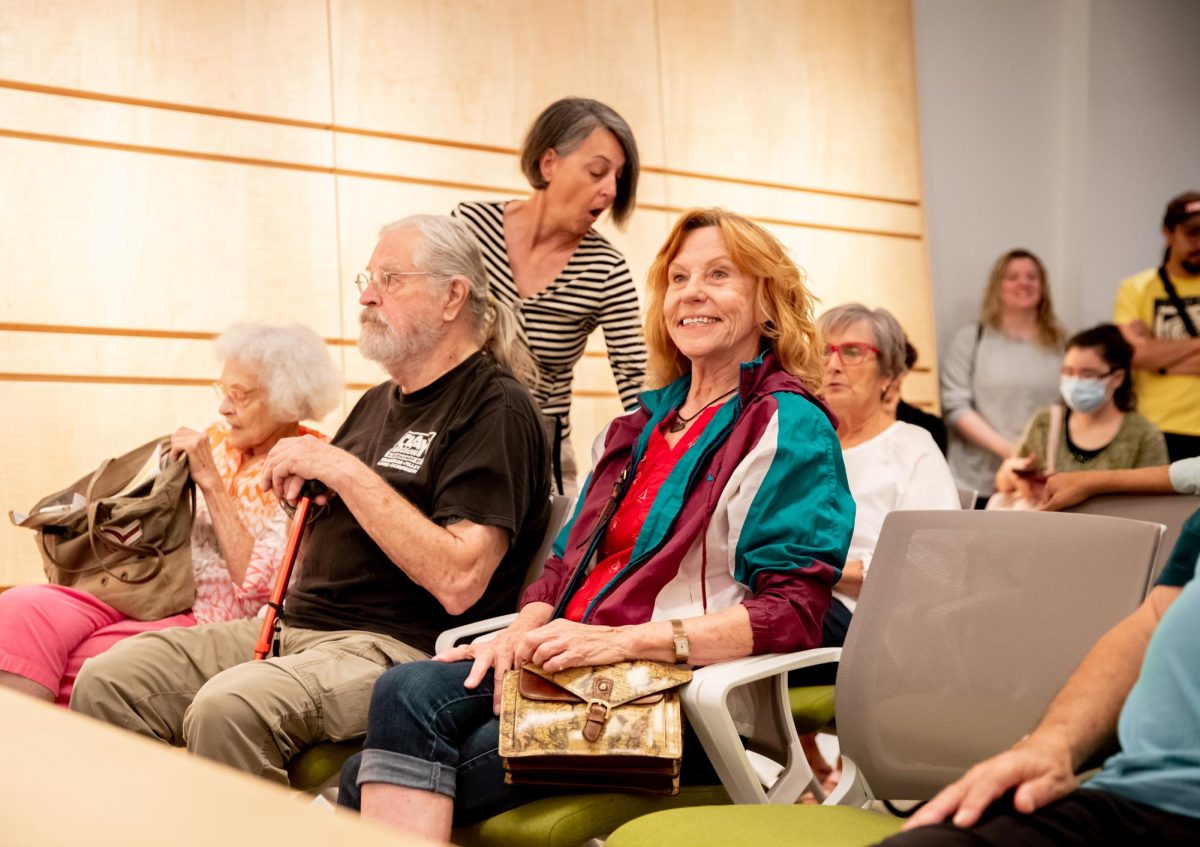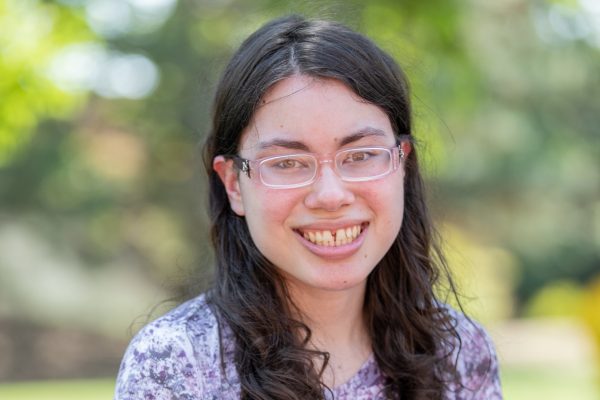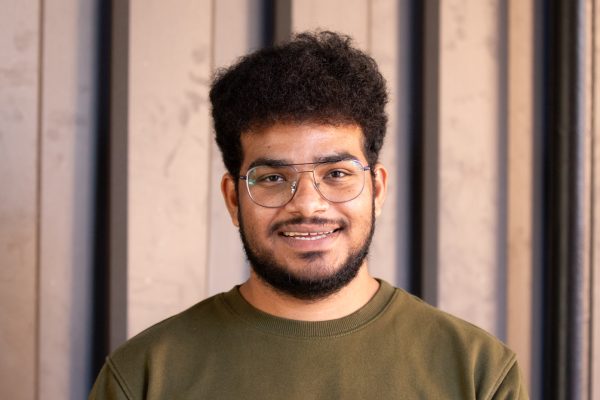While working in the Ulrich Museum of Art, Austin Storie often watches families connect over his artwork. His digital animated piece incorporates video game and cartoon characters like Mario and Hello Kitty, and he enjoys hearing families share memories around them.
“I’m really interested in how we shape our identities through how we consume,” Storie, the operation manager, said. “It was very interesting to see that my idea was making sense to people.”
Storie discussed his process in an artist talk on Wednesday, alongside three other Ulrich Museum employees. All have their work featured in the museum’s staff exhibition until Aug. 5.
Storie, a 2022 Wichita State graduate, said TV has influenced his artwork the most. With his blind father “always home,” the two would watch old shows that Stories’ father had enjoyed, leading Storie to play with nostalgia and commercialism within his art.
“I was America’s worst nightmare. I was sat in front of the TV with no parental supervision, and that was what raised me,” Storie said. “So my work is a representation of the life that I’ve lived through the lives that I’ve watched on the screen as a child.”
Outside of the museum, Storie works in publishing illustration, usually conveying others’ ideas. He said it was interesting to figure out the message for his exhibit piece.
“It’s been interesting to kind of unlock this other side where it’s like … ‘What do I want to say? What do I want people to think about me or what I’m making?”’ Storie said.
Pop culture also proved influential for James Porter, the exhibition designer and production manager. He finds inspiration from various media, such as choosing artworks’ titles from books and emulating patterns from 60s and 70s knitting magazines.
“You have all this reference material on the floor around you, and you’re constantly looking at it to have a vocabulary in the studio,” Porter said. “The more chaos, the better. The images create its own story.”
Porter’s exhibit works span different mediums, including collages, charcoal portraits and bronze pieces. When starting his art career, he was a trade sculptor and worked in bronze casting. Heavy lead poisoning led him to step away from those creations.
“I was like, ‘I am 21 years old. I am a machine,’” Porter said. “And then 30 years later, you’re like, ‘Oh, I should’ve (taken precautions).”
Porter said his past classes made returning to drawing a smooth transition. Switching to paper and charcoal also saved expenses, compared to bronze.
While Porter said it can be challenging to squeeze in creative time alongside his day job, art allows him to experiment.
“I get to do the chaos at home, knowing that the chaos is an escape from this,” Porter said.
Growing up, Joanne Ramondetta was fascinated by the historical costumes from shows she watched with her parents. Initially, the office and finance manager wanted to sew costumes but found her skillset aligned better with two-dimensional art.
Ramondetta’s exhibit pieces are acrylic on canvas, including landscapes and fruit surrounded by ornate borders. She said many works were inspired by the Italian Renaissance.
“Once I got the idea in my head, I spent about two years searching every single antique shop, searching eBay … to find Italian frames,” Ramondetta said.
With a love for patterns and designs, Ramondetta spent years gathering materials and taking photos of architecture on different trips, which inspired her paintings.
“The process of getting me there to paint is pretty organized because I have to do so much research,” Ramondetta said.
While Ramondetta’s artwork is “deeply personal,” she said her mother and other influences have helped shape her aesthetic.
“I do think that I do collaboration, just from the images I have in my room to the people that I’ve met in my life,” Ramondetta said.
Ramondetta, business manager for the Ulrich, said she never anticipated doing a math-related job, but she has loved learning to formulate the language around art into numbers.
“The Ulrich is like home for me,” Ramondetta said.
Jo Reinert, registrar and collections manager, describes her art process as “chaotic” and “very therapeutic.” In her abstract paintings, she said she impulsively applies her first paint layers, with the following layers being more intentional.
“I’m very reactive in my process,” Reinert said. “I really am responding to the needs of the composition.”
Working mostly with organic shapes, Reinert said her inspirations are from environments and nature. She also creates collage works, using pieces from past works.
Reinert said her art background makes her museum position more fulfilling while she works in logistics.
“I understand the artwork … and who made it and why they made again,” Reinert said.
While Reinert said creating art alongside a day job can be difficult due to sometimes lacking the “mental bandwidth,” she finds developing routines can be helpful. Art also allows her moments to play and be in a “free state.”
The Ulrich Museum staff also touched on how artificial intelligence (AI) can generate artwork. Ramondetta said she finds AI “terrifying.”
“I tend to have (art) done the old school way with critical thinking,” Ramondetta said.
Reinert said she was excited about AI, but fearful of its capabilities. She highlighted how previous technological advances like the printing press made people wary and discussed regulating AI.
“We’re going to have to learn how to, as a society, regulate (AI) in a lot of ways,” Reinert said.
Storie noted that in his experience in commercial illustration, some agencies already screen for and won’t accept any illustration created by AI.
Storie said AI artwork can have downsides, such as allowing people unfamiliar with art to compete with artists with years of practice, but he is excited about AI’s possibilities.
“I think that more and more people will eventually begin to recognize how important craft is in the creation process,” Storie said. “When you have that dialogue, you have better, deeper work that connects people … We’ll see if this (change is) good in five years, but it’s inevitable.”





